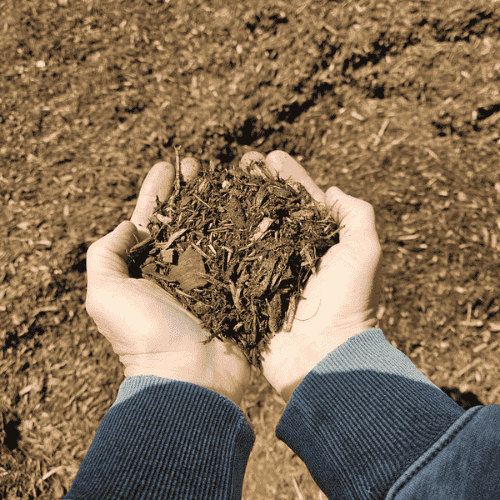
When it comes to creating healthy, beautiful flower beds, it’s easy to focus only on the visible elements—lush blooms, clean edging, and a tidy layout. But one of the most powerful tools for long-lasting flower bed success lies beneath the surface: organic mulch.
If you’ve ever wondered whether adding mulch is worth the effort, the answer is a resounding yes—especially when you choose an organic mulch like shredded bark, wood chips, or compost. More than just a finishing touch, mulch plays a crucial role in your garden’s health and longevity.
In this article, we’ll break down the top benefits of organic mulch for flower beds, and how you can use it to create thriving, low-maintenance landscaping that looks great season after season.
🌿 What Is Organic Mulch?
Organic mulch refers to any natural, biodegradable material spread over the surface of soil. This includes:
- Shredded hardwood bark
- Pine bark nuggets
- Wood chips
- Straw
- Leaves
- Compost
Unlike inorganic mulches (such as stone, rubber, or plastic), organic mulch decomposes over time, improving the soil while offering many other benefits.
🌞 1. Helps Regulate Soil Temperature
Think of mulch as a cozy blanket for your garden beds. In hot summer months, mulch shields soil from excessive heat, protecting the delicate root systems beneath. During cooler seasons, it acts as insulation, keeping the ground warmer for longer and reducing stress on your plants.
A consistent soil temperature creates a stable growing environment—especially helpful for perennials or sensitive flowering plants.
💧 2. Retains Moisture and Reduces Watering
One of the standout benefits of organic mulch is how effectively it helps retain soil moisture. By covering the soil surface, mulch reduces evaporation and helps keep water where your plants need it: around the roots.
Especially during dry spells or hot New Jersey summers, this can make a huge difference in how often you need to water. For homeowners and landscapers alike, mulch is a simple yet powerful water-saving strategy.
🌱 3. Improves Soil Quality Over Time
Unlike inorganic materials, organic mulch breaks down slowly, adding valuable nutrients back into the soil as it decomposes. This natural process improves:
- Soil texture (better drainage and root penetration)
- Fertility (adds nitrogen, carbon, and other nutrients)
- Microbial activity (supports healthy bacteria and worms)
The result? Healthier soil, which leads to stronger, more vibrant plants.
🚫 4. Suppresses Weed Growth
Weeds compete with your flowers for sunlight, water, and nutrients—and they often grow faster. A generous layer of organic mulch acts as a physical barrier, blocking sunlight and preventing weed seeds from germinating.
Fewer weeds mean:
- Less time spent pulling or spraying
- Cleaner, more attractive flower beds
- Reduced use of herbicides
Just make sure you apply mulch at a depth of 2 to 3 inches to get the best weed-suppressing effect.
🐛 5. Supports Healthy Ecosystems
Mulching isn’t just about what your eyes can see. A well-mulched garden also promotes life beneath the surface. Organic mulch creates a rich environment for beneficial organisms such as:
- Earthworms
- Soil microbes
- Fungi that aid nutrient absorption
These natural allies help aerate the soil, decompose organic matter, and improve overall plant health—all without you lifting a finger.
🌸 6. Protects Plant Roots
In New Jersey’s changing climate, sudden weather shifts can stress flower beds. A layer of mulch helps protect shallow plant roots from:
- Heavy rains (which can erode soil)
- Harsh winds
- Frost damage in spring and fall
Mulch keeps your root systems stable and protected, leading to longer bloom periods and hardier plants.
🎨 7. Enhances Curb Appeal
Let’s not forget aesthetics! Organic mulch adds an instant clean and polished look to flower beds. Whether you choose natural brown, deep black, or richly dyed red mulch, the contrast against green foliage and colorful flowers makes everything pop.
It also defines bed lines, prevents soil from splashing onto blooms, and keeps landscapes looking professional.
⚠️ Tips for Applying Organic Mulch Correctly
To get the most from your mulch, proper installation is key. Here are some guidelines:
- Apply 2–3 inches deep (don’t overdo it)
- Keep mulch 1–2 inches away from stems to prevent rot
- Replenish annually as it breaks down or fades
- Avoid compacting mulch; a light, fluffy layer is best
For flower beds, a shredded bark or fine wood mulch works well—it settles nicely and breaks down at a manageable pace.
🚚 Where to Buy Organic Mulch in New Jersey
If you’re ready to enhance your flower beds with premium mulch, trust Kirk Allen Landscape Supply. Located in northern New Jersey, they offer a wide range of bulk and bagged mulch options, including:
- Natural bark mulch
- Dyed black, brown, and red mulch
- Playground-safe mulch
- Compost and topsoil blends
Their knowledgeable staff can help you choose the right mulch for your project and calculate how much you’ll need.
📞 Get Expert Advice from Kirk Allen Landscape Supply
Need help picking the right mulch for your flower beds? Want bulk delivery straight to your home or job site?
Reach out to the experts at Kirk Allen Landscape Supply. They’re here to help homeowners, landscapers, and contractors get the most from their outdoor projects.
📍 Website: www.kirkallenlandscapesupply.com
📞 Phone: 973-347-3117
🌼 Final Thoughts
Whether you’re planting perennials, annuals, or a mix of both, organic mulch is one of the best investments you can make for your flower beds. It’s more than just a finishing touch—it’s a functional, beautiful, and environmentally friendly way to nurture your garden.
With benefits ranging from improved soil health to reduced maintenance, mulch makes your flower beds not only look better but perform better too.

